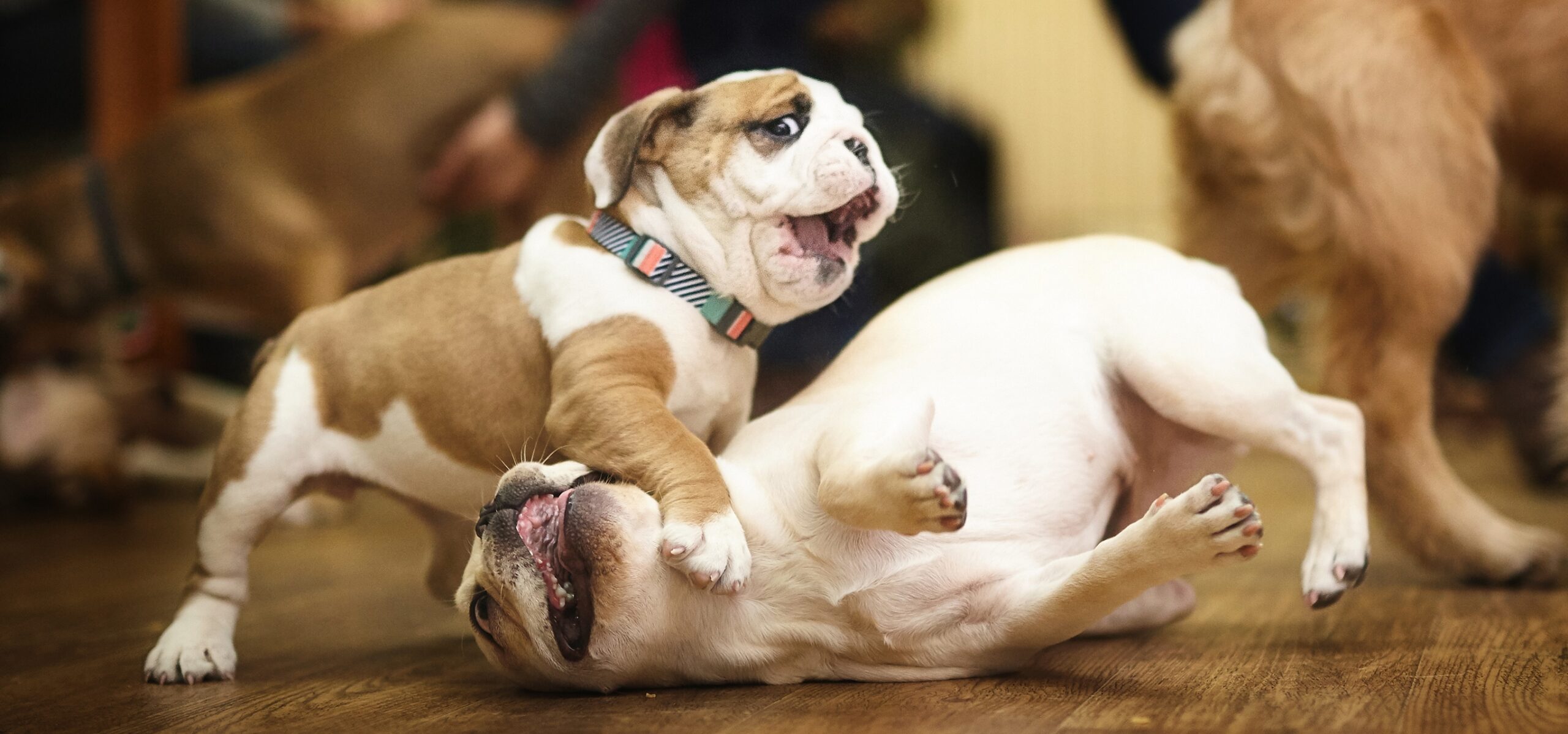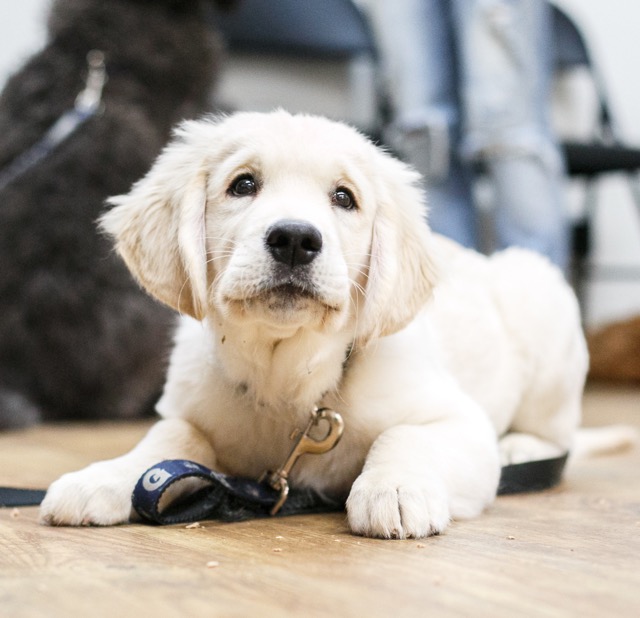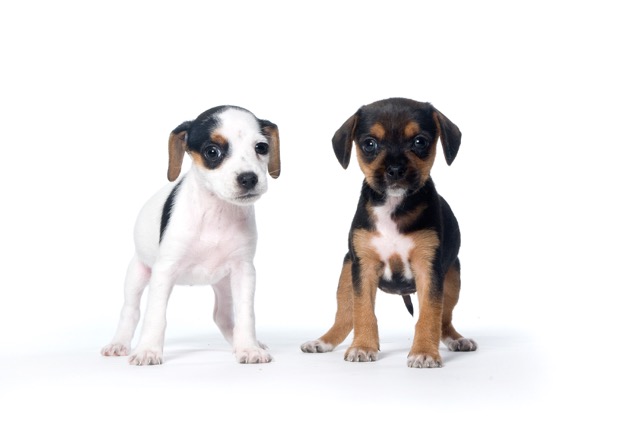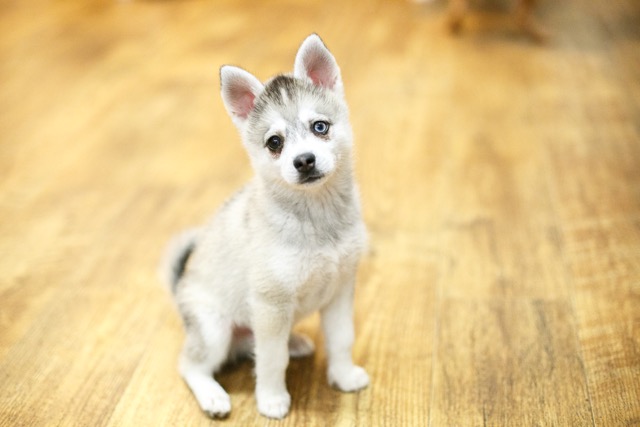
Socialization at Puppy Play Groups
Moderating puppy play groups is definitely one of the highlights of my job. After all, there are few things that are cuter than baby animals frolicking and playing. Hence the popularity of Animal Planet’s Puppy Bowl. But, for a trainer who is required to moderate these groups there is a lot more that is required than just sitting back and watching the fun. Careful observation, focus and management is required to ensure the best possible experience for all.
The Importance of Play in Puppy Development
Play is an important component of a puppy’s educational curriculum. Not only does it provide them with an outlet for their abundant puppy energy, but it is also one of the cornerstones of developing an adult dog who can best handle social interactions with other dogs. Being able to interact and play with other dogs throughout their lifetime can be a wonderful form of enrichment and should ideally be part of a plan to maintain a dog’s overall well-being. That is not to say that all adult dogs will be interested in or suitable for play with all other dogs. In fact, it is quite normal as a dog develops into adolescence and adulthood that they become more particular about who they play with. Sounds a lot like people. But, the goal is to make the most of a dog’s unique temperament so that they have the best possible chance of trotting through their life with their family without serious incidents with other dogs.
Even if a dog grows into an adult who is not exceptionally fond of playing with other dogs, early and consistent interactions with other dogs during puppyhood provides them with valuable information in regards to bite inhibition. That is, how to control or inhibit the frequency, and most importantly the force with which they use their mouths with other dogs. An adult dog may growl, snap or even nip at another dog at some point in their life. But, early and ongoing socialization with other dogs bodes well for any interactions of this sort to end with both dogs walking away without injury. It is somewhat like people getting into an occasional verbal scuffle with someone else. This is something that even the most even-tempered person might experience. But, we should all be able to walk away from these situations with nothing more than a momentary bit of annoyance. Allowing dogs the opportunity to play with other dogs during their crucial development period (prior to 26 weeks-old) is one of the easiest and most effective ways to help set a foundation for safe and enriching encounters with other dogs throughout their lifetime.
Normal Puppy Play Behaviors
Puppies are programmed to play as a way of practicing behaviors that will serve them well throughout their lives. During puppy play groups you are likely to observe a whole host of natural and normal behaviors. Some of these can be a bit disconcerting and even alarming to those who are unfamiliar with normal puppy play. There is likely to be lots of running, chasing, and mouthing, as well as some barking and even the occasional mounting. There are also likely to be moments when one or more of the pups chooses to opt out of play. The social structure of dogs is one that is flexible and constantly changing depending on the environment and other specifics of the situation. So, while I observe the puppies as they enter the room for each play date, in order to get a sense of what they are about, I know that once they are playing with each other, the interactions can vary greatly and change from moment to moment.
As I watch pet parents head in the door, usually with obvious expressions of enthusiastic anticipation for the fun their pup is about to have, I begin to assess each dog/handler team so as to best manage the hour ahead. A few weeks ago there was a 3 month-old Shepherd mix who came bounding in with his family a few feet behind at the end of the leash. From the looks of things it was immediately clear that shy, reserved, and cautious are strangers to him. He gave a few quick glances and sniffs en route, but wanted to be on the fast track to getting to were he wanted to go. This was only his second visit to this puppy play group, but he seemed to know full well what was through the door. As our school is located in New York City, we see loads of smaller dogs. On this particular night, a scrumptious tri-colored Cavalier King Charles Spaniel almost tip-toed into the space. She was cautious of each step and stood at the doorway for a full minute before crossing the threshold. Next on the lineup was a Boston Terrier who, like the Shepherd mix puppy, was surely wishing his humans could understand that he was trying to say “Please, unsnap my leash already! I want to run, and play, and sniff!” If only he could speak human. All two pounds of a Chihuahua puppy pranced in with little head and tail held high. If that body posture doesn’t scream “I may be small, but watch out world!” I don’t know what does. A low-key Bernese Mountain Dog rolled up to the door, followed by two very cute fluffballs (a Havanese and a Shih Tzu). All three seemed to be from the same tribe; mild-mannered and taking each step in stride.
Structuring Play Groups for Safety
The lineup that followed included a little terrier mix, a Pekingese mix and two bouncy Labrador mixes who were adopted from Animal Haven Shelter. Pulling up the rear was a beautiful Vizsla who crept in with her head held low and her tail tucked all the way under her belly. She was clearly worried, but her people seemed even more so. They looked distraught and immediately asked if maybe it would be best if they just took her home.
It can take courage to expose your new puppy to situations for which it may take them time to adjust. While it is certainly understandable that some pet parents are reluctant and concerned when faced with a situation such as this, (this is especially common and understandable for people with very small, and presumably more fragile dogs), avoiding exposure to the world at large (in this case, to other dogs) means that you are simply delaying the inevitable and most probably making it that much more difficult for your dog to develop the confidence to handle those things which he or she will be exposed to throughout their life. That is not to say that the pups response to experiences should not be considered. In fact, quite the opposite. I explained to the family with the Vizsla that while all the pups there would benefit in many ways from attending puppy play groups, their dog was sending out a high alert message that socialization was a top priority for them. I also assured them that we would take steps to help her adjust gradually to the situation and that odds were she would be romping and playing very soon. While it takes some puppies a few weeks to come out of their shell and gain the confidence to playfully interact with other puppies, most get the hang of things in one or two sessions.
Managing Different Confidence Levels
Just as the social structure of dogs is flexible, so must be a person moderating a puppy play group or puppy kindergarten class. On this particular night, I sectioned off the room so that one side was for the more confident pups and the other for those who would benefit most from a more gradual introduction to other puppies. The separation was also based in part on the vast discrepancy in size. While the goal is to have all the pups learn to be in the presence of other dogs of varying sizes, interact safely (whether on leash or off), and feel confident and secure in their ability to handle these social situations, at this point it seemed there were some pups in the room who had not yet developed the impulse control necessary to interact safely with dogs that are much smaller. I had the Vizlsa, the Cavalier King Charles Spaniel, the Havanese, Shih Tzu, the little terrier mix, Chihuahua and the Boston Terrier in one half of the room and sectioned them off from the other area with two exercise pens stretched across the room. The Shepherd mix, Bernese Mountain Dog and the Labrador mixes where on the other side.
We started by allowing the Vizsla and the Cavalier off leash while everyone else gently held their pups. This way, the two pups who seemed most concerned had some time to adjust to the space prior to meeting the other puppies. The pups being held were getting a valuable opportunity to practice remaining calm when restrained, even in a stimulating environment. Food stuffed chew toys were passed around to those people holding their pups, to be used as behavioral pacifiers to ensure that being held and restricted from play was associated with something pleasant. This sort of simple exercise is an added bonus during play sessions and will serve the pups and their families well in the future when they need to be restrained in a similarly stimulating situation (i.e. at a vet’s office or dog run).
Encouraging Positive Interactions
The Vizsla and the Cavalier gently padded about the room in ever widening circles until their two little faces were just inches apart. Both pups sniffed the ground, looked and turned away and then back until a beautiful moment when the Cavalier placed her front end on the ground and stretched into a full out play bow. The Vizsla paused and then flopped to the ground. The two of them stared in each others eyes for a moment and then the Vizsla was up and running with the little tri-colored pup doing her best to catch up. There were giggles all around the room and sighs of relief from the parents of these pups. I asked the others to let their pups down one at a time, pointing to each to indicate when it was their turn. As each pup entered the mix, the Vizsla and Cavalier became more cautious for a moment or two, but as each pup made an introduction to the others, by sniffing and circling about, the room became filled with wonderful displays of soft, inviting puppy body language.
On the other side of the space, the four larger pups bounded around the room, chasing and being chased. The Bernese flopped to the ground after about ten minutes and the other pups followed suit. Lots of mouthing about the neck and rolling on the floor fun were had by all. I asked a number of people to pick their pups up for momentary time outs from play for the purpose of keeping the energy at a controllable level and to help the pups regain some composure when necessary. As a puppy play group moderator I am looking for pups to develop the ability to interact with each other with soft, bouncy body language. Consistent stiff posturing is usually an indication that a time out might be in order. But, in most cases this type of posturing subsides after a few moments.
Addressing Common Concerns
Sometimes when two pups are engaged in rigorous, wrestling type play, one or the other pet parent might express concern that their dog is not having fun. In this case I might suggest to do a quick restraining hold on the other pup a foot or two away. If the pup whose parents were concerned comes back to play, it is a clear indication that while the pet parent might not have thought their pup was having fun, they were! This is a technique for guaging interest in play that is best suited for young puppies, not adult dogs.
In most cases, puppy play groups are great time for all. But, at times what is fun for one pup may not be so much so for another. I heard one pet parent whisper that they thought the Boston Terrier was being dominant. I prefer to look at it in a way that allows more room for understanding. The Boston Terrier was, in this particular environment anyway, feeling more confident, and in the mood to play in a rambunctious manner than some of the pups. He was also especially interested in the Cavalier (she is a very pretty girl). At this stage in the Boston’s social development he was not yet skilled at picking up on this other dogs clear signals that she was not interested in playing this way. If the Boston backed off a but it might be that the Cavalier would gradually gain the confidence to play. But, as he was very insistent, I had the parents rotate which pup was down playing and which was being held. By two weeks later, the Cavalier had become confident enough to interact with the Boston Terrier, who had himself started to become much more polite in regards to backing off when other pups gave clear signals that they were uncomfortable. These signs may include a lowering of their head and/or tail, averting their gaze, lip licking, or yawning.
The Shepherd mix puppy won the award for most time-outs for the evening, but I assured his people that while he was definitely a supremely confident and energetic boy, the time outs where not an indication that anything was wrong with him. Just that in this particular group it would benefit him and the other pups to let him take frequent breaks. As it turns out, when he came back the next week, there were two new puppies who were even more confident than him. At this session he had just a few time-outs, but they each had quite a few more. Yet another example that social groups are fluid and a dog’s behavior will change according to many variables.
Mounting is one of the behaviors that tends to be of greatest concern to new pet parents. Mounting can mean many things, including acting as an invitation or encouragement to play. In most cases, when a puppy mounts another they will do so for a very brief bit of time and then stop of their own accord or as a result of the other pup sitting, lying down or turning around to play. However, if this behavior becomes excessive a time out from play is in order. This is not only to help prevent this behavior from become excessive, but also to relieve concerns that pet parents on both sides of the equation may have.
Each puppy play group is in some ways like a little episode of a sitcom with a cast of characters who entertain themselves and you throughout the hour. But, the ultimate purpose of a puppy play group is far more important than just entertainment. It is to set the stage for a well-socialized adult dog. If you have a new puppy or are planning on welcoming one into your family soon, be sure to make a plan for providing your pup with as many of these valuable opportunities to interact with other pups as possible. Some options are:
Join a Puppy Kindergarten Class ASAP. Not only will you learn loads about how to best communicate with your new puppy, but this is also a wonderful place to work on habituating your dog to environments and people outside of your home.
Attend weekly Puppy Play Groups so as to provide your pup with multiple opportunities for off leash play with other puppies of varying sizes.
Schedule Puppy Play Dates with friends and neighbors with well socialized and healthy puppies and adult dogs. One on one play time is often a stepping stone for a pup to build greater confidence with dogs in general. Essentially, one canine buddy can lead to a more open attitude to making another, and another and so on.
Explore Our Dog Training Courses
Educate your dog with Andrea Arden and her team.
New York | Los Angeles | Connecticut
Share
- Group Classes
- Private Lessons
- Virtual Training
- Puppy Play Groups
- Puppy Training
- Articles & Advice




